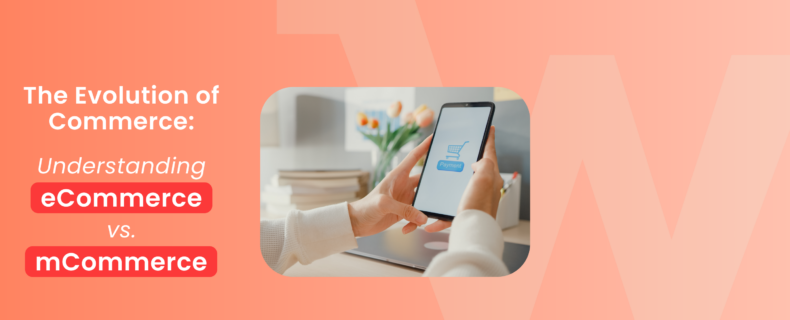Commerce has undergone a transformative evolution, moving beyond traditional brick-and-mortar stores. With the rise of technology, we’ve witnessed the emergence of eCommerce and its mobile counterpart, mCommerce.
In this blog post, we’ll explore the distinctions between eCommerce and mCommerce, their significance, and the role of mobile commerce in the modern business landscape.
Defining eCommerce
eCommerce, or electronic commerce, refers to the process of buying and selling goods and services online. It encompasses a wide range of online transactions, from purchasing clothing and electronics to booking travel accommodations. eCommerce has become a global phenomenon, with online marketplaces and retail websites acting as digital storefronts for businesses of all sizes.
According to Shopify, the global eCommerce market is expected to total $6.3 trillion in 2023 and account for 21.2% of total retail sales, showcasing its immense economic impact. This figure is expected to continue its upward trajectory, further solidifying eCommerce’s position in the global marketplace.
One of the driving forces behind eCommerce’s growth is its unparalleled convenience. Shoppers can peruse products, read reviews, compare prices, and make purchases from the comfort of their homes or while on the go. This convenience has not only revolutionised consumer shopping habits but has also provided businesses with the means to reach a global audience without the limitations of physical stores.
Understanding mCommerce
Mobile commerce, or mCommerce, is a subset of eCommerce that centres on transactions conducted through mobile devices such as smartphones and tablets. Over the past decade, mCommerce has witnessed exponential growth, largely due to the widespread adoption of smartphones and mobile apps. Today, it stands as a pivotal component of the eCommerce landscape.
According to Statista, mCommerce is estimated to reach $2.2 trillion in 2023 and make up 60% of all eCommerce sales around the world. This statistic highlights the significant shift toward mobile devices as the preferred medium for online shopping.
The primary distinction between eCommerce and mCommerce is the device utilised for transactions. While eCommerce encompasses online shopping conducted on desktop and laptop computers, mCommerce revolves around the seamless shopping experience mobile devices offer. This shift is monumental as it has redefined consumer behaviour, making shopping even more accessible and immediate.
Key Differences between eCommerce and mCommerce
- Device Accessibility: The most conspicuous difference lies in the device used for shopping. eCommerce encompasses transactions conducted on computers, whereas mCommerce is tailored exclusively to mobile devices.
- User Experience: Mobile apps have revolutionised the shopping experience by providing user-friendly interfaces and personalised recommendations. Mowico, a leading no-code eCommerce mobile app builder, empowers businesses to create mobile apps that offer intuitive and efficient shopping experiences, catering to the preferences of mobile users.
- Location Independence: With mCommerce, consumers can shop from virtually anywhere. This level of flexibility allows businesses to engage customers in real time, capitalising on impulsive buying behaviour.
- Payment Methods: mCommerce frequently incorporates mobile payment methods such as digital wallets and one-click payments, streamlining the checkout process and enhancing convenience for mobile users.
- Push Notifications: Mobile apps enable businesses to send push notifications to users, notifying them of special offers, new arrivals, or order updates. This direct communication channel is instrumental in increasing customer engagement and retention.
The Significance of mCommerce in Modern Business
The rise of mCommerce carries profound implications for businesses across all scales. Here’s why it’s so significant:
- Accessibility: Mobile devices are omnipresent. By embracing mCommerce, businesses can tap into a colossal user base that prefers the convenience of shopping on the go.
- Customer Engagement: Mobile apps offer a direct channel for communicating with customers through push notifications and in-app messaging. This opens opportunities for personalised marketing and improved customer support.
- Competitive Advantage: In an increasingly crowded eCommerce market, having a mobile app can set businesses apart from the competition. It’s especially crucial for small businesses looking to establish a robust online presence.
- Enhanced Conversion Rates: Research indicates that mobile apps often boast higher conversion rates compared to mobile websites. The ease of use and personalised experiences offered by mobile apps frequently lead to increased sales.
- Data-Driven Insights: Mobile apps collect valuable data on user behaviour, preferences, and interactions. This data is a goldmine for refining marketing strategies and tailoring product offerings to meet customer needs effectively.
Conclusion
eCommerce and mCommerce signify the evolution of commerce in the digital age. While eCommerce has made online shopping accessible and convenient through desktop computers, mCommerce has taken it a step further by placing shopping experiences directly in the hands of mobile device users. The primary differences between these two concepts lie in the devices used, user experiences, and payment methods.
In today’s business landscape, mCommerce has emerged as a potent force, offering businesses the opportunity to engage with customers on a more personal level, boost sales, and gain valuable insights. As consumer preferences continue to shift toward mobile devices, businesses that embrace mCommerce are well-positioned to thrive in this mobile-first era.
By recognising the distinctions between eCommerce and mCommerce and adapting your strategies accordingly, you can seize the opportunities presented by this dynamic and ever-evolving digital commerce landscape.






